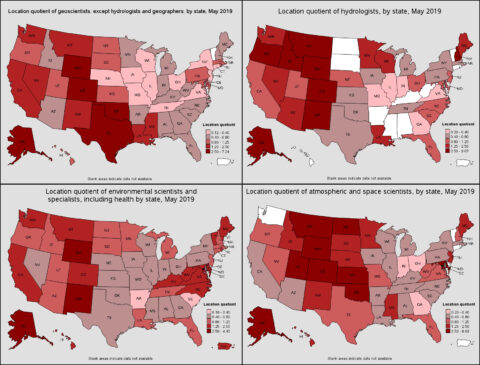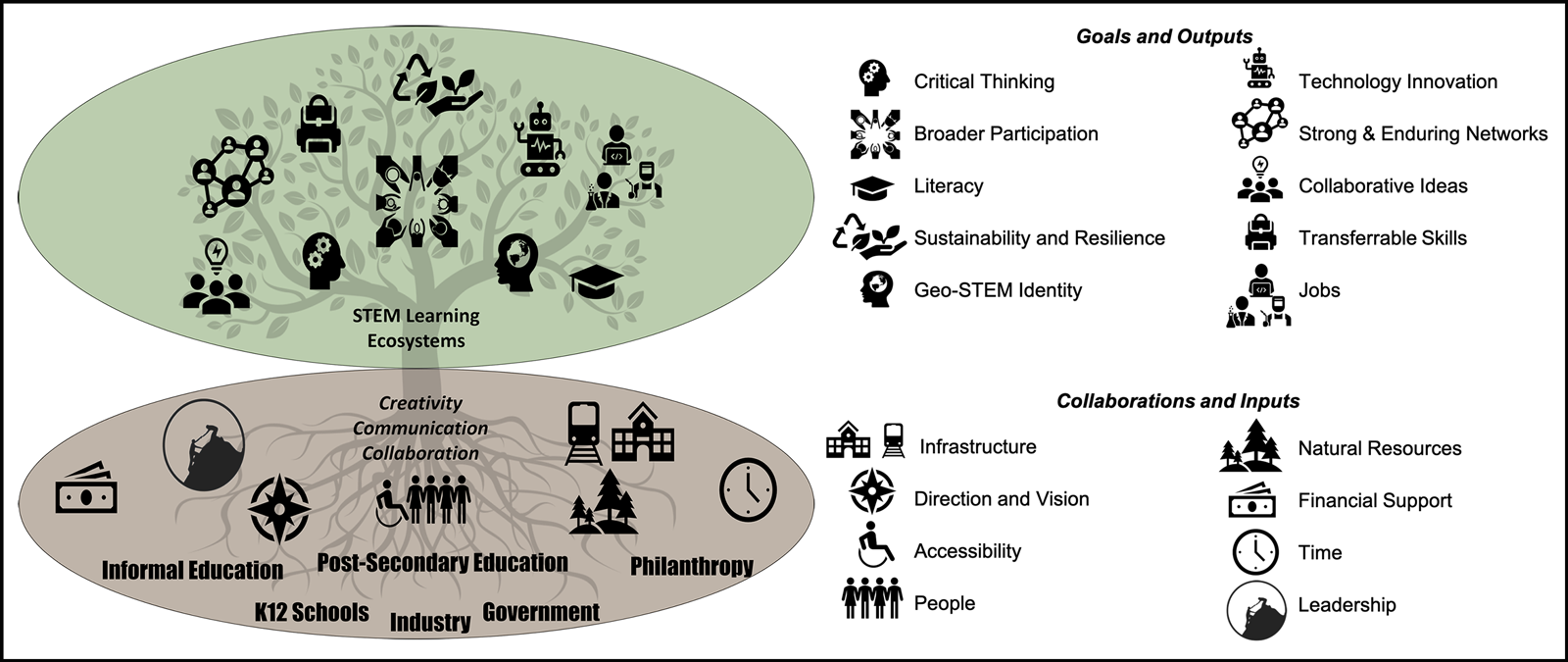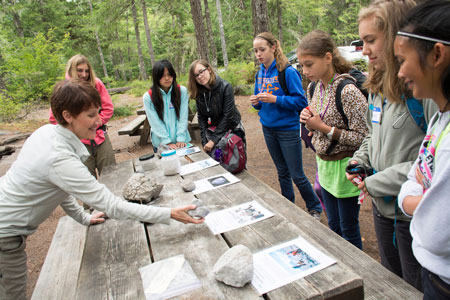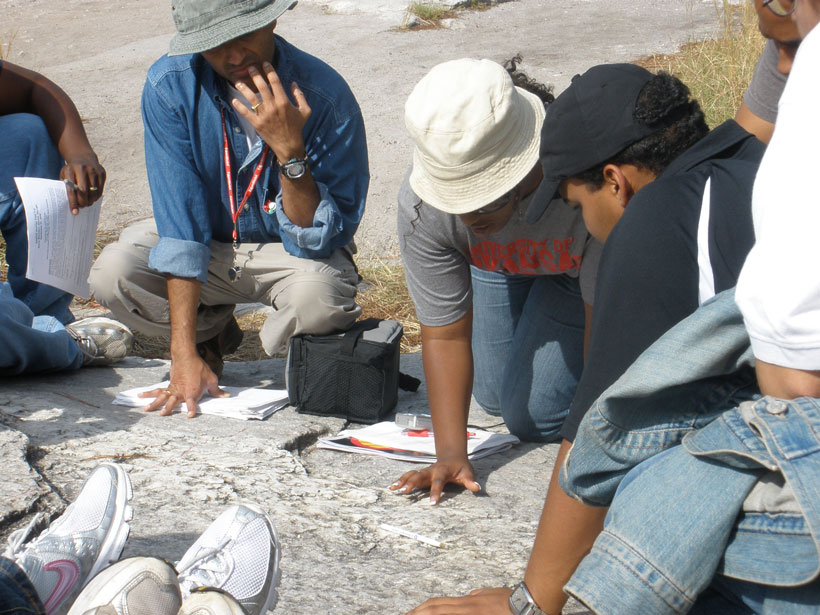Geoscience expertise is required to solve societal problems like seismic hazards, coastal erosion, and ensuring adequate clean water supplies. These problems, which are often local in scale and impact, are most likely to be solved when the sources of geoscience expertise consulted are also local (and thus highly invested in finding solutions) and when they work collaboratively with the community. An example of science-community collaboration was demonstrated in September 2013, when Denver area geoscientists responded quickly to community concerns about nearby flash flooding. The scientists assessed flood effects on the landscape, soils, and water and air quality and communicated critical information to the public.

Geoscientists tend to be concentrated in regions rich in natural resources and geologic hazards (Figure 1). However, areas outside these regions are still faced with numerous environmental and natural resource–related challenges, which will likely persist without local geoscience expertise and community awareness. As communities work to become more resilient and sustainable, they need access to place-based education that’s unique to the local people, cultures, landscapes, and ecology [Apple et al., 2014].
One way to achieve sustainable local solutions is to invest in community geoscience education that integrates science, technology, engineering, and mathematics (STEM). Collaborations that adopt this approach, known as Geo-STEM learning ecosystems, involve partnerships among diverse organizations throughout a community—from K–12 schools and higher education institutions to museums, local businesses, and government organizations—that join together to address a local issue and to engage more young people in the geosciences. Any community can create Geo-STEM learning ecosystems to cultivate community literacy and motivate sustainable and transformative solutions. More such programs are certainly needed. Maybe your community can build the next one.
A History of STEM Learning Ecosystems
In a seminal 2014 report, Kathleen Traphagen and Saskia Traill defined STEM learning ecosystems (Figure 2) and emphasized that developing these systemic collaborations requires buy-in from a variety of community organizations [Traphagen and Traill, 2014]. That same year, the National Academies held a convocation on building learning ecosystems at which participants explored challenges and developed recommendations. In December 2018, the National Science and Technology Council’s Committee on STEM Education issued a 5-year strategic plan that charged government agencies with fostering STEM learning ecosystems to unite communities around STEM education.

Several examples of STEM learning ecosystems have demonstrated success by engaging and educating people of all ages about new innovations and garnering sustained community support. The most recognized of these are the Burroughs Wellcome’s STEM Learning Ecosystems Communities of Practice (STEMCoP), which consist of 89 ongoing and sustainable projects around the world that teach young people STEM-related ways of thinking, content, and skills. STEMCoP encourages K–12 students’ interest in STEM fields, especially within the health sciences, computer technology, and robotics. Few of the STEMCoP efforts involve students in place-based investigations of local ecosystems, however, and none emphasize the geosciences.
Geo-STEM Takes Off
More recently, three programs that foster geoscience-focused STEM learning ecosystems have emerged. AGU’s Thriving Earth Exchange has facilitated 135 place-based collaborations globally (and another 27 will begin soon). In these collaborations, scientists, community leaders, and sponsors work together—typically without the same explicit focus on students that STEMCoP has—to solve local challenges related to climate change, water quality and availability, natural hazards, natural resources, ecological systems, and healthy communities. To date, only 10 of these collaborations have had specific educational components that either created materials for local schools or engaged K–12 students in geoscience-related investigations and problem solving.
Students engage in service learning and conduct research through place-based projects that elevate geoscience concepts related to water quality, erosion, and land use.
Another program, Educational Partnerships for Innovation in Communities–Network (EPIC-N), connects undergraduate and graduate students with local community leaders to investigate and develop sustainable solutions and to improve community well-being through urban planning. Projects address traffic and mass transit, homelessness, waste management, and gentrification. Students engage in service learning and conduct research through place-based projects that elevate geoscience concepts related to water quality, erosion, and land use. Of the 29 EPIC-N programs to date, only 2 addressed community education explicitly, and these have concluded.
EarthConnections and the Supporting Emerging Aquatic Scientists (SEAS) Islands Alliance are two STEM learning ecosystems that have been supported by the National Science Foundation’s (NSF) INCLUDES (Inclusion across the Nation of Communities of Learners of Underrepresented Discoverers in Engineering and Science) Program. EarthConnections, a 2016 INCLUDES pilot project, created 11 alliances that supported the development of pathways by which precollege students can access geoscience learning opportunities. Each alliance engaged multiple parts of a community and helped participants explore career tracks by addressing local geoscience-related challenges. EarthConnections is currently seeking support to sustain ongoing activities.
The SEAS Islands Alliance establishes community networks focused on coastal geosciences in U.S. and affiliated island jurisdictions, including in the U.S. Virgin Islands, where the SEAS Your Tomorrow program “fosters curiosity, instills stewardship, and forges and strengthens educational pathways for Virgin Island youth to explore and secure careers in marine science” through culturally relevant, place-based learning opportunities, according to the program’s website. Funding from various NSF programs—INCLUDES, EPSCoR (Established Program to Stimulate Competitive Research), and HBCU-UP (Historically Black Colleges and Universities–Undergraduate Program)—enables professional societies, formal and informal education entities, local governmental and nongovernmental organizations, and universities and colleges on the islands and in the mainland United States to collaborate to achieve social change around geoscience problems.
Of the projects noted above, 112 function as STEM learning ecosystems; 71% of these encourage and facilitate STEM learning in urban communities, with 68% engaging youth from urban communities that have been traditionally underrepresented. The concentration of learning ecosystems in urban communities is to be expected, as the ecosystems are often associated with urban colleges, universities, and organizations like museums that provide out-of-school learning opportunities. Of the urban STEM learning ecosystems that engage precollege learners, however, only five programs currently address any geoscience concepts.
Twenty-nine percent of the 112 STEM learning ecosystems address the needs of rural communities, with a handful of these ecosystems having a specific objective to address the needs of Indigenous learners. Within this 29%, only Thriving Earth Exchange, EarthConnections, and SEAS learning ecosystems have addressed geoscience content areas specifically. Learners in rural and remote communities would benefit from stronger connections to Geo-STEM learning ecosystems because these communities are heavily affected by issues of water quality and availability, soil health and erosion, climate change, natural resource extraction, and food security.
Opportunities for New Geo-STEM Learning Ecosystems
There is no one right way to set up a Geo-STEM learning ecosystem because each one is unique to its location, the engaged partners, and the target audience.
Creating Geo-STEM learning ecosystems that address the needs of different communities presents both challenges and opportunities. There is no one right way to set up a Geo-STEM learning ecosystem because each one is unique to its location, the engaged partners, and the target audience. Sustainable programs will require strong but flexible organizations, sound infrastructure, dedicated personnel, and long-term funding. Should individuals or organizations wish to cultivate a Geo-STEM learning ecosystem, here are some suggested steps.
First, find a credible and engaged lead organization, such as a museum or outreach center, that is committed to collaborating with schools, educational organizations, academic institutions, industry, utilities, local governments, and other nontraditional partners. These diverse partnering organizations should reflect community demographics and demonstrate respect for each other’s expertise.
Next, identify and reach out to potential partners. (Don’t worry if the list is long to start; that just means you have a lot of options.) Once you have narrowed the list of collaborators, work with them to identify goals that maximize learning opportunities for the target audience—such as engaging learners to understand local seismicity, coastal erosion, or pollution—and to create accessible, robust, and connected learning experiences for the audience. Examples of such learning experiences include multistage bridge programs that help middle and high school students see themselves as geoscientists, encourage undergraduates to participate in research, and facilitate postgraduate professional opportunities.

Then, you’ll need to secure funding to meet your goals—it is likely you will need both start-up funding and sustained long-term funding. In addition to the INCLUDES program, another potential route to secure start-up funding is through NSF’s Improving Undergraduate STEM Education GEOPAths (Pathways into the Earth, Ocean, Polar and Atmospheric & Geospace Sciences) program. The goal of GEOPAths is to increase the number of students pursuing undergraduate and postgraduate geoscience degrees by promoting the design and testing of novel approaches that engage students in authentic, career-relevant experiences. Multiple GEOPAths funding tracks support geoscience learning for broad audiences in informal settings (i.e., museums, nature centers) and for undergraduates and graduate students in academic settings.
Each Geo-STEM learning ecosystem will have its own unique goals, but the overarching goal should be to engage more young people in the geosciences and promote geoscience literacy for generations to come. Unlike more general STEM learning ecosystems in which kids build robots or do cool science experiments, these Geo-STEM ecosystems focus young people on solving local geoscience issues related to water quality, pollution, soil erosion, natural resource management, and hazard mitigation—all issues that pose significant ongoing challenges for many communities and can engage young people with their local natural landscapes and with their neighbors.
Giving students intriguing and relevant local geoscience problems to solve is an effective way to cultivate their interest and create a sense of belonging.
For geoscientists, these programs are both self-serving and altruistic. To diversify the geoscience community and expand our scientific capabilities, we can attract young people who might not otherwise have seriously considered geoscience careers. Giving students intriguing and relevant local geoscience problems to solve is an effective way to cultivate their interest and create a sense of belonging. Ultimately, however, these programs educate and serve local communities by addressing local problems.
Creating New Pathways to Geoscience
Geo-STEM learning ecosystems offer researchers, professionals, and educators opportunities to broaden geoscience participation by activating local formal and informal education networks, supporting K–12 Earth system science learning, and building a strongly skilled local workforce. Geoscientists in all domains can work together to help frame community needs, to collaborate with educational providers to reach K–12 audiences directly, and to host professional learning opportunities for teachers.
The greatest opportunities lie in developing these ecosystems to include K–12 education in urban, rural, and Indigenous communities. Successful existing STEM learning ecosystems suggest that Geo-STEM learning ecosystems are worth serious investment and have considerable potential to capture students’ imaginations and motivate them to develop the skills needed to identify and solve a host of geoscience-related problems affecting communities around the world.
References
Apple, J., J. Lemus, and S. Semken (2014), Teaching geoscience in the context of culture and place, J. Geosci. Educ., 62(1), 1–4, https://doi.org/10.5408/1089-9995-62.1.1.
Traphagen, K., and S. Traill (2014), How cross-sector collaborations are advancing STEM learning, Noyce Found., Los Altos, Calif., www.informalscience.org/working-paper-how-cross-sector-collaborations-are-advancing-stem-learning.
Author Information
Cheryl L. B. Manning ([email protected]), Northern Illinois University, DeKalb
Citation:
Manning, C. L. B. (2020), Engaging communities in geoscience with STEM learning ecosystems, Eos, 101, https://doi.org/10.1029/2020EO147934. Published on 10 August 2020.
Text © 2020. The authors. CC BY-NC-ND 3.0
Except where otherwise noted, images are subject to copyright. Any reuse without express permission from the copyright owner is prohibited.

